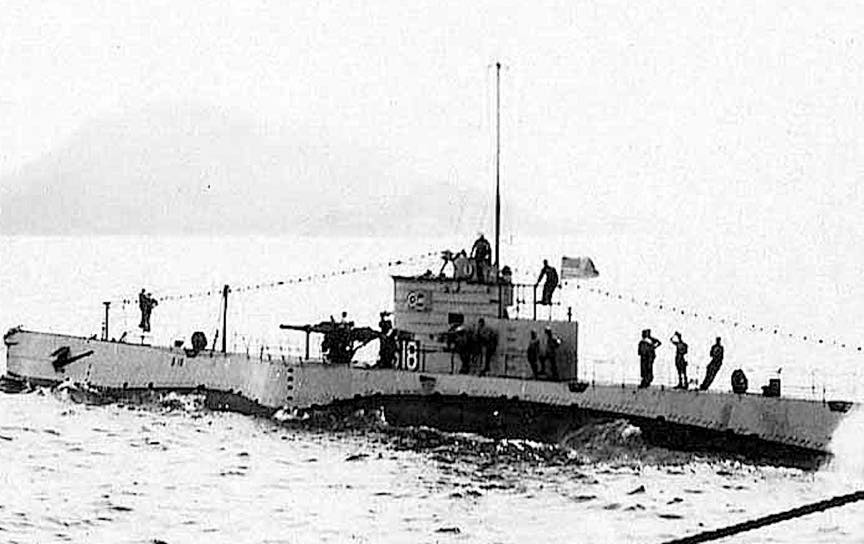
S-18
(SS-123: dp. 854 (surf.), 1,062 (subm.), 1. 219'3"b. 20'8"; dr. 15'11" (mean); s. 14.5 k. (surf.), 11 k.(subm.); cpl. 42; a. 1 4", 4 21" tt.; cl. S-1)
S-18 (SS-123) was laid down on 15 August 1918 by the Bethlehem Shipbuilding Corp. Quincy, Mass.Launched on 29 April 1920, sponsored by Miss Virginia Bell Johnson; and commissioned on 3 April 1924, Lt. Elliot M. Senn in command.
From 1924 through 1929, S-18 operated out of New London, primarily off the New England coast but with annual deployments to the Caribbean for winter maneuvers and fleet problems. Transferred to the Pacific fleet in 1930, she departed New London on 24 May
operated off the California coast into the fall, and arrived at her new home port, Pearl Harbor, on 7 December.
For the next 11 years S-18 remained based at Pearl Harbor. In September 1941, she returned to the west coast; and, three months later, after the United States had entered World War II, the submarine was ordered to the Aleutians.
A unit of Submarine Division (SubDiv) 41, S-18 moved north in mid-January 1942. Into March, she conducted defensive patrols out of the new and still incomplete submarine base at Dutch Harbor. In mid-March, she got underway for San Diego; underwent repairs there until mid-May, then returned to the Aleutians.
En route, on the 29th, the S-boat received orders to patrol the southern approaches to Umnak Pass in anticipation of a Japanese attack. On 2 June, she took up her station. The next day, the Japanese sent carrier planes against Dutch Harbor and landed troops on Kiska and Attu. The war in the Aleutians had begun.
Orders for submerged daylight operations in combat areas compelled the World-War-I design submarines of the north Pacific force to increase their submerged time to 19 hours a day. Surfaced recharging time was cut to the brief 5 hours of the northern summer night.
Hampered by fog, rain, and poor radio reception; and lacking radar, fathometer, and deciphering equipment; S-18 remained on patrol through the 10th. The next day, she returned to Dutch Harbor. On the 13th she was underway again to patrol west and north of Attu, then north of Kiska. The weather, as on earlier patrols, was consistently bad. Habitability in the S-1 class boat was poor. Material defects and design limitations in speed and maneuverability continued to plague her.
On the 29th, she sighted an enemy submarine but was unable to close. The same day, she returned to Dutch Harbor; and, as at the conclusion of previous patrols, her commanding officer requested up-to-date sound and radar equipment.
From 15 July to 2 August, the S-boat conducted another patrol in the Kiska area; and, on completion of the patrol, she was ordered to San Diego.
In October, S-18 returned to the Aleutians and, on the 22d, she cleared Dutch Harbor for her next patrol, again in the Kiska area. On 3 November, however, she was recalled and ordered to prepare for a longer, more distant patrol. On the 12th she put to sea, but, on the 15th, a crack in the starboard main engine housing forced her back to Dutch Harbor.
She arrived on the 20th, and her repairs were completed by the end of the month. On the 30th, S-18 resumed her patrol, moved west, and operated off Kiska, Kiskinato, Agattu, and Attu. On 22 December after 16 days in her patrol area, she lost her starboard stern plane; and depth control became erratic. On the 28th, she returned to Dutch Harbor.
Repairs and refit took S-18 into the new year, 1943 and, on 7 January, she got underway again. During that 28 day patrol, her last, she reconnoitered Attu and the Semichi Islands. On 4 February, she was ordered back to San Diego, for overhaul and assignment to training duty.
For the remainder of World War II, S-18 remained in the San Diego area, providing training services for the West Coast Sound School. In late September 1945 she moved north to San Francisco where she was decommissioned on 29 October. On 13 November, her name was struck from the Navy list; and, a year later, her hulk was sold for scrapping to the Salco Iron and Metal Co., San Francisco.
S-18 earned one battle star during World War II.
